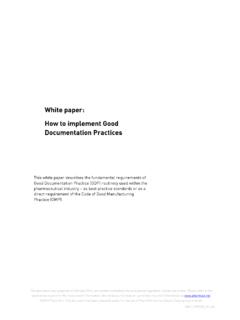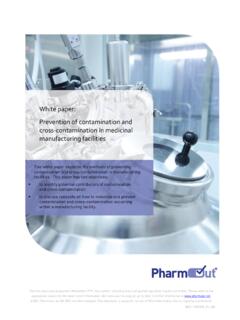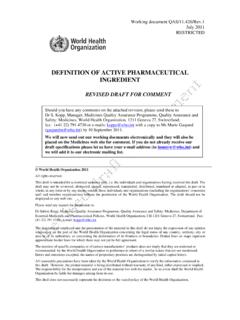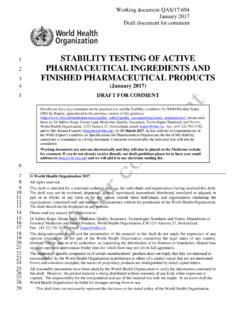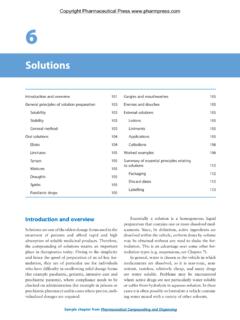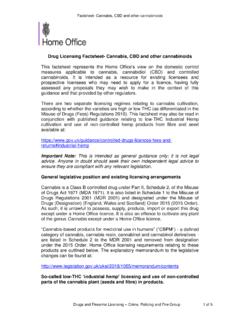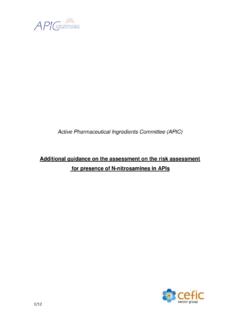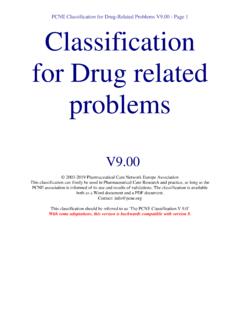Transcription of FDA Guidance for Industry Update – Process Validation
1 This document was prepared in February 2016, any content including links and quoted regulation may be out of date. Please refer to the appropriate source for the most recent information. We endeavour to keep an up-to-date record of information at 2016 PharmOut. This document has been prepared solely for the use of PharmOut and its clients. Copying is prohibited. MKT_TMP200_01_r06 White paper: FDA Guidance for Industry Update Process Validation In January 2011, the FDA released the final version of its long-awaited Update to its Process Validation Guidance for Industry . Since then, the Guidance has fueled international debate by suggesting significant changes to Process Validation strategy, urging the implementation of a continuous improvement Process , as opposed to strict adherence to previously established operating procedures.
2 PharmOut white paper: FDA Guidance for Industry Update Process Validation PharmOut Pty Ltd, ABN: 85 117 673 766, Unit 10, 24 Lakeside Drive, Burwood East, Victoria 3151. Ph: +61 3 9887 6412, Fax: +61 3 8610 0169, Email: Web: 2016 PharmOut. This document has been prepared solely for the use of PharmOut and its clients. Copying is prohibited. Page 2 of 10 MKT_TMP200_01_r06 Introduction The United States Food and Drug Administration (FDA) is responsible for assuring the safety, efficacy, and security of products sold in the USA in the categories of human and veterinary drugs, biological products, medical devices, cosmetics, and products that emit radiation.
3 To facilitate this purpose, the FDA issues Guidance documents for auditors and Industry to help define the practical expectations of meeting the US GMP regulations. In January 2011, the FDA published an updated Guidance entitled Guidance for Industry - Process Validation : General Principles and Practices. This document replaces the FDA s 1987 Guidance document, Guideline on General Principles of Process Validation . The 1987 document was written when Process Validation was a relatively new concept to the Industry , which has now evolved in the 20+ years between the publications. The new version brings the Guidance document into the 21st century by including evolutionary developments, as well as introducing the newest concepts in Process Validation .
4 Unlike the Codes of Federal Regulations (CFR), FDA Guidance documents are not legally binding, and alternative approaches are acceptable provided they satisfy the requirements of the applicable regulations. They do, however, provide the best information on the current thinking of the regulator, and following them goes a long way to ensuring compliance. Who is affected by the changes? Manufacturers will be directly affected by the changes if they sell products into FDA regulated markets in the following categories: Human drugs Veterinary drugs Biological and biotechnology products Drug constituent of a combination drug/device Both finished product and active pharmaceutical ingredient (API) manufacturers are affected.
5 While not directly affected, manufacturers of products in the above categories who are not currently regulated by the FDA can still benefit from this new Guidance , which represents up-to-date thinking from one of the world s key regulators. PharmOut white paper: FDA Guidance for Industry Update Process Validation PharmOut Pty Ltd, ABN: 85 117 673 766, Unit 10, 24 Lakeside Drive, Burwood East, Victoria 3151. Ph: +61 3 9887 6412, Fax: +61 3 8610 0169, Email: Web: 2016 PharmOut. This document has been prepared solely for the use of PharmOut and its clients. Copying is prohibited. Page 3 of 10 MKT_TMP200_01_r06 Manufacturers of the following product types are specifically excluded from the scope of the Guidance .
6 Where alternative Guidance or regulation is used by the FDA, it has been specified: Product Type Relevant Guidance /Regulations Type A medicated products (articles and feed) for animal use NA Medical devices Global Harmonisation Task Force SG3/N99-10: Quality Management Systems Process Validation Guidance ed. 2 (2004) Dietary supplements NA Human tissue FDA Guidance for Industry : Validation of Procedures for Processing of Human Tissues Intended for Transplantation (March 2002) What are the key changes in the new Guidance ? The updated Guidance is virtually a complete rewrite of the 1987 document. There is very little retained wording from the original, although the general intent of the documents is similar.
7 In saying this, there are several key points of difference, from the formal definition of Process Validation , to emphasis on product life cycle and risk management concepts. The key differences are explained below. Process Validation Definition For years, many in the Industry have been able to recite the FDA s 1987 definition of Process Validation . The 2011 Guidance has updated the definition and shifted the focus from documentation to scientific evidence throughout the product life cycle. 1987 Definition 2011 Definition establishing documented evidence which provides a high degree of assurance that a specific Process will consistently produce a product meeting its pre-determined specifications and quality characteristics the collection and evaluation of data, from the Process design stage throughout production, which establishes scientific evidence that a Process is capable of consistently delivering quality products In the past, Process Validation emphasis has been on collecting large quantities of data from Validation batches, leading to a perception of Process Validation as largely a documentation exercise.
8 The updated approach requires the manufacturer to collect data throughout the product life cycle and evaluate it scientifically and assess if it supports a quality Process . PharmOut white paper: FDA Guidance for Industry Update Process Validation PharmOut Pty Ltd, ABN: 85 117 673 766, Unit 10, 24 Lakeside Drive, Burwood East, Victoria 3151. Ph: +61 3 9887 6412, Fax: +61 3 8610 0169, Email: Web: 2016 PharmOut. This document has been prepared solely for the use of PharmOut and its clients. Copying is prohibited. Page 4 of 10 MKT_TMP200_01_r06 Focus on alignment with product lifecycle The FDA is a party to the International Conference on Harmonisation (ICH) for human pharmaceuticals.
9 The ICH publishes guidelines on quality, safety, efficacy and multidisciplinary topics. Quality guidelines Q8 ( pharmaceutical Development), Q9 (Quality Risk Management) and Q10 ( pharmaceutical Quality System) are directly referenced in the new FDA guideline. The FDA has also referenced the ASTM E25001, where the focus has shifted from Validation of individual parts of a Process , to a collective Process Validation effort that takes a more holistic view of Process , highlights the GxP critical parts of the Process and focuses efforts and resources on the most critical aspects. Of specific importance to the Validation Guidance is the concept, detailed in these quality guidelines, of product lifecycle.
10 The new Guidance has been aligned with this concept, giving the following three-stage approach to Process Validation : Stage 1 Process Design Stage 2 Process Qualification Stage 3 Continued Process Verification. The Guidance provides specific examples of what sort of Validation activities are expected at each stage. Each stage is briefly summarized in the table below. Stage Intent Typical Activities Process Design To define the commercial Process on knowledge gained through development and scale up activities The outcome is the design of a Process suitable for routine manufacture that will consistently deliver product that meets its critical quality attributes A combination of product and Process design (Quality by Design)




